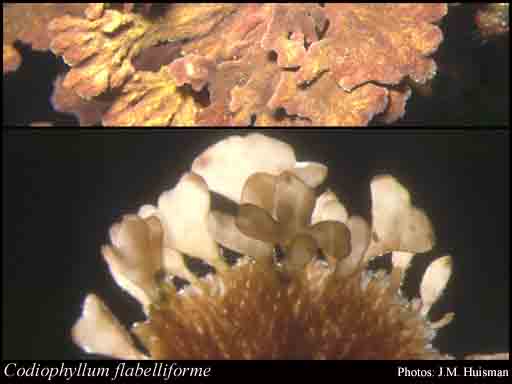- Reference
- Bot.Jahrb.Syst. 146 (1895)
- Conservation Code
- Not threatened
- Naturalised Status
- Native to Western Australia
- Name Status
- Current

Scientific Description
Habit and structure. Thallus medium to dark red-brown, 10–30 cm high, with one to several subterete to flat or flanged woody stalks 5–17 cm long and 0.5–2.5 cm broad, irregularly branched above with flabellate lamellar meshworks 5–12 cm long, 4–8(–11) cm broad and 1–2.5 mm thick, composed of 4–10(–12) separated, irregular layers of subparallel filiform branchlets, producing an uneven or wavy surface resulting from changes in numbers of layers. Holdfast massive, woody, 1–5 cm across, divided; epilithic. Structure of filiform branchlets and stalks of a pseudoparenchymatous cortex 4–8 cells thick of isodiametric cells and a dense medulla of elongate filaments with occasional refractive ganglioid cells. Secondary cortication of stalks extensive, with up to 38 growth rings, and the interstices between the filiform branchlets becoming filled by the secondary growth. A thin layer of sponge usually (but not always) covers the filiform branchlets and the upper stalks, but not the lower stalks.
Reproduction. Reproductive structures confined to special, small, compressed leaflets, 4–8 mm long, 2–4 mm broad and 500–600 µm thick, produced as extensions of the filiform branchlets mainly from the upper edges of fronds and largely free of sponge; cortex broad (5–10 cells) and medulla narrow (50–100 µm across). Sexual thalli monoecious with the female structures on thicker central parts of the leaflet and male in sori nearer the margins. Carpogonial branches situated on inner cortical cells, 2-celled, with no or indistinct ampullary filaments. Auxiliary cell ampullae situated in outer medulla with branched secondary and tertiary filaments extending through the cortex, auxiliary cell elongate; carposporophyte ovoid, with the basal auxiliary cell remaining, carposporangia ovoid, 6–9 µm in diameter, with the ampullary filaments remaining as a slight to moderate involucre. Spermatangia in distinct sori with elongate initials 1(–2) cells long and 1–2 µm in diameter and ovoid spermatangia. Tetrasporangia in nemathecia with paraphyses 40–50 µm and 3–4 cells long, 3–4 µm in diameter, tetrasporangia elongate-ovoid, 25–35 µm long and 8–10 µm in diameter, cruciately divided.
Distribution. Dongara to King George Sound, W. Aust.
Habitat. C. flabelliforme typically grows horizontally or is pendulous from the roofs and sides of shaded reef undercuts.
[After Womersley, Mar. Benthic Fl. Southern Australia IIIA: 216–218 (1994)]
Distribution
- IBRA Regions
- Geraldton Sandplains, Jarrah Forest.
- IBRA Subregions
- Geraldton Hills, Southern Jarrah Forest.
- IMCRA Regions
- Abrolhos Islands, Central West Coast, Leeuwin-Naturaliste, WA South Coast.
- Local Government Areas (LGAs)
- Albany, Augusta Margaret River, Cockburn, Esperance, Greater Geraldton, Irwin.